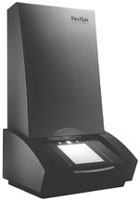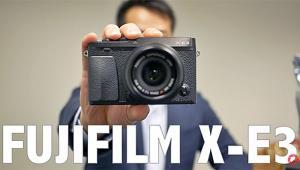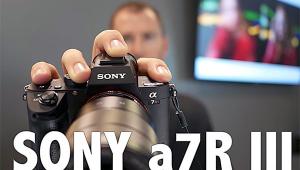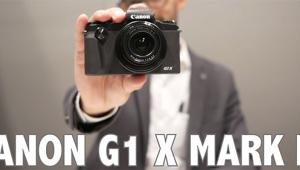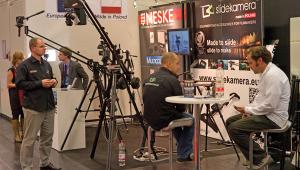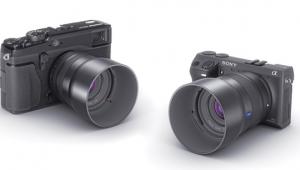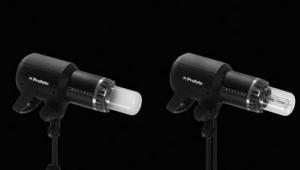PMA International
Professional Digital Cameras, Film Scanners, And Storage
My first impression entering
PMA '99, a little before the trade show opened, was provided by
MegaVision with their new S3 2048x3072 pixel medium format digital camera
back for single shot use with all types of illumination. This new chip,
also featured by several other competitors, provides performance which
speaks of maturity in digital photography and image processing. The
MegaVision group were photographing an unusually beautiful model with
rich red hair, a flawless, creamy complexion, and striking features.
The resulting Fuji Pictography prints exceeded what I would expect from
120 film using a 645 or 6x6 SLR in sharpness and refinement and in the
realism of the rendering of subtle delicate tones. |
|||
The maturation of digital photography
was further revealed by Kodak's introduction of the DCS 620 digital
camera built into the Nikon F5 body. This new 620 model features a 2Mp
chip combined with the latest Nikon professional SLR camera body features.
It offers the Nikon system user the latest in digital image capture utilizing
all of the lenses and special applications features developed by Nikon
in conjunction with the latest Kodak digital technology. In addition to
adding a new dimension of choice to what is offered to the news gathering
profession, this 620 is also ideally suited to forensic, scientific, government,
and military applications. Nikon's cast metal body and the 3.5 sec
burst rate, plus ISO 200-1600 "film" speed selectivity provides
a wide range of applicability. Accurate results are assured with an on-board
histogram display and captured in 36-bit color depth. Field use is enhanced
with dual PCMCIA slots built-in as well as a removable rechargeable battery.
The suggested price of the DCS 620 is $16,995. |
|||
A year after introducing their
striking and unusual entry into professional digital photography with
the S1, Leica has improved and elaborated the offering with a new sensor
providing improved signal to noise ratio and increased light sensitivity.
They now call it the Leica S1 Pro. In addition, this new model has an
anti-flicker function which permits its use with light sources without
a high frequency ballast. Leica has also added a binning function which
combines several pixels together into one image point, which increases
the effective film speed. This has resulted in a much shorter scanning
time without any loss of image resolution or quality. The S1 Pro now creates
a maximum 152MB file size in 3x16-bit depth. The new model is priced at
$21,500. |
|||
For those aspiring to do professional
quality digital photography, hoping that some kind of "back"
will be available to convert an existing 35mm SLR, Minolta has created
an alternative solution that avoids the problem of the high cost of a
CCD sensor large enough to fill a 24x36mm frame. By marrying two 1.5Mp
CCD sensors and then building a body which utilizes the Minolta Vectis
APS interchangeable lens system, Minolta will offer the Dimâge RD
3000. This all-new digital camera solution features high quality 2.7Mp
capture. This is accomplished by a built-in mirror splitting the image
and capturing it on the camera's two separate CCD sensors, and then
combining the halves seamlessly as a single output file. The images may
be stored in uncompressed TIFF for compressed JPEG format on a compact
flash card, or IBM's new 340MB MicroDrive card. |
|||
Frequently some products one sees at large trade shows for one reason or another don't make it to the retail market. One, which I saw at the '98 PMA in New Orleans that impressed me, is now available in the U.S.A. It is a uniquely small, versatile, and at $9999 it is a cost-effective digital scanning camera, called the Kaiser Scando dyn A+, distributed by HP Marketing. It is just a bit longer in one dimension than a pro 35mm SLR and utilizes 35mm SLR-type lenses, but unlike other "small" digital cameras, this one is a line-scanning type like the big digital backs for 4x5 cameras. Even though the scan area is relatively small it is quite high in resolution producing 3648x4625 pixel images and a 48MB image file. It also features LaserSoft SilverFast software which is among the best color correction tools available. What makes the Scando dyn A+ really intriguing is the fact it can be used as a high resolution 35mm slide and film scanner, a print scanner, as well as a studio still life camera, and you can use many of the lenses you might already have in a 35mm SLR system. |
|||
Even though there are digital
cameras now for all occasions, there are many more film cameras still
in use as well as billions of pictures already stored on film. So, the
hybrid marriage of analog and digital utilizing a scanner remains attractive
and film scanners enjoy continued technological improvement with many
new and improved products shown at PMA. Although Hewlett-Packard is well
known and respected in computer circles, I don't think photographers
or for that matter yours truly took their PhotoSmart line of products
as seriously as they deserved. In particular I've found the PhotoSmart
scanner has been well received by many serious photo enthusiasts. Now
there is even more reason to take this versatile and inexpensive $499
scanner seriously. HP has thoroughly improved every feature which had
any weakness in the original model, including increasing the scan color
depth to 36-bit, comparable to models costing many times as much. Now,
besides scanning both 5x7 prints and strips of film, the HP PhotoSmart
S20 photo-scanner will handle slides and mounted negatives with even greater
ease and simplicity. To make it compatible with the latest PCs, HP has
also added a USB connection for easier and more efficient transfer of
image data to a computer. But most significant, in addition to easy to
use software with automated scan adjustments, HP has added a full array
of color correction tools which are simple to access and conform to the
prevailing standards established for years in image-editing software.
This makes the HP PhotoSmart S20 the most affordable means to make high
2400dpi professional quality scans of 35mm film images. |
|||
At the high end and still affordable
realm of 35mm slide scanning, Polaroid revealed a new SprintScan 4000.
The 4000 designation in the name refers to a new level of 4000dpi in maximum
scanning resolution for a desktop 35mm film scanner. And, even with this
added resolution and the larger file size it produces, the name SprintScan
is still appropriate as these scans are made in under one minute. Other
physical attributes include new film strip and mounted slide handling
which also supports easy batch scanning of four or six images with one
"load" of the scanner. Possibly as significant as the new
physical capabilities, Polaroid has vastly improved the software provided
with the SprintScan 4000. In addition to their IQA automatic color correction
and image optimization, an entirely new, more powerful, and easier to
use manual color correction tool set is a part of the package called Polaroid
Insight Pro Software. These improvements should not overshadow the fact
the SprintScan 4000 also scans at an exceptionally high 3.4 density range
at a color depth of 12 bits per RGB channel. This new Polaroid SprintScan
4000 is priced at $2495 and will be available immediately. |
|||
Photographers were presented
with the unique film scanning abilities of the Imacon Flextight Precision
scanner for the first time at PMA '98 in New Orleans. This unique
scanner combines the basic design functions, including a high resolution
of 5760dpi, of a CCD drum scanner capturing at a color depth of 14 bits
per RGB channel. The Imacon Flextight uses its exclusive vertical form
factor with a direct to lens light path, which altogether with its other
special features provides superior scan quality combined with unusual
ease of use. Now this top performing professional film scanner has been
made available to the Windows 98 PC user with a new SCSI connectivity
kit and newly programmed software including full support of Microsoft
ICM 2.0 color management. This new Windows software completely mirrors
the Mac version in features and functionality, assuring accurate color
and efficient transfer of that data to the host PC. |
|||
Kodak, in partnership with
Intel, Adobe, and Epson, announced the soon to be launched national program
to bring Kodak Picture CD to the general population implemented by a widespread
upgrade to existing photofinishing suppliers across the nation. Picture
CD is a means of storing and accessing snapshot photographs made with
today's ubiquitous point-and-shoot cameras currently serviced by
thousands of minilabs and similar photofinishing services. It involves
digitizing the images and putting them in moderately high-resolution compressed
files on a Picture CD which is delivered to the customer as part of their
photofinishing order. The Picture CD also involves a well designed and
developed software program which supports easy access for computer users
to use the pictures stored on the Picture CD to make their own prints,
send pictures via e-mail, share them over the net, and employ them in
all kinds of documents with their computers. The Picture CD will also
be a means to take photos stored on them to a photofinisher to make digital
prints if the user does not have a computer printer, and will also facilitate
print services which will be made available in Kiosks which will begin
to appear in key locations in retailing areas throughout the nation. Picture
CD is the logical culmination of what was begun many years ago by Kodak
with PhotoCD, to make digital photo processing economically and conveniently
available to all consumer snap-shooters. |
- Log in or register to post comments






